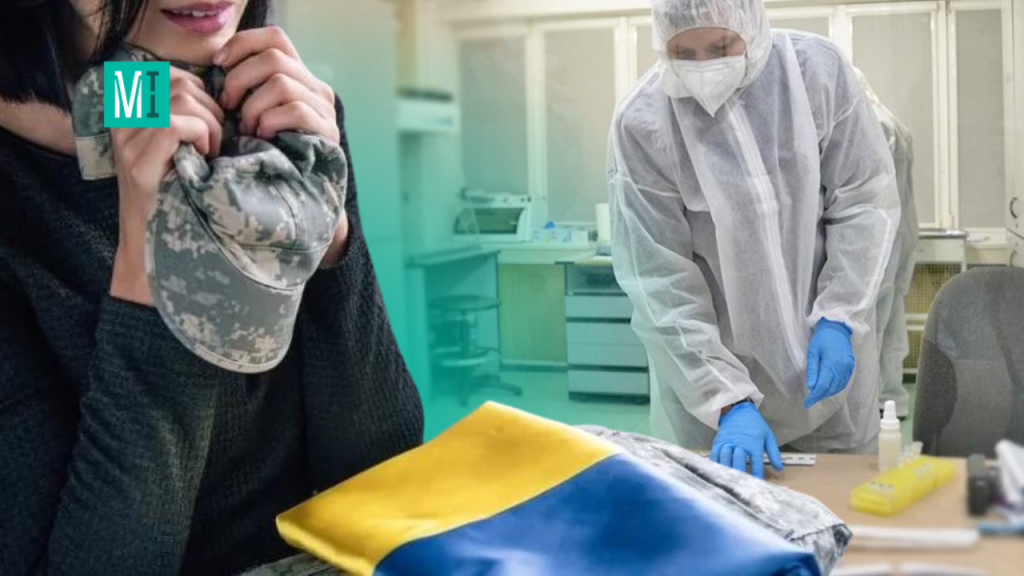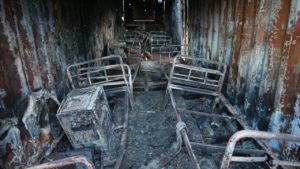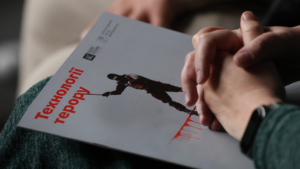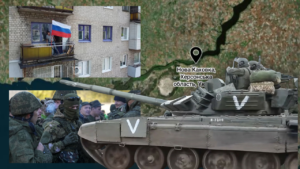How to Accelerate the Identification of Those Killed or Missing in the War

As of September 26, 2024, the Unified Register of Persons Missing under Special Circumstances, operated by the Ministry of Internal Affairs of Ukraine, contains 55,000 records of people missing during the war. As of August 2024, the Register recorded 2,410 unidentified bodies (remains). MIHR has prepared an analytical report on the issues related to the identification of the deceased, how to expedite this process, and what to do if a relative has gone missing in the war.
A person is considered missing if they have disappeared under special circumstances, such as armed conflict, military actions, the temporary occupation of part of Ukraine’s territory, or emergencies of a natural or human-made nature. A person is deemed missing under special circumstances when an applicant files a report of their disappearance. The individual acquires legal status as a missing person once information about them is entered into the Unified Register of Persons Missing under Special Circumstances. The Register includes missing civilian adults, children, and military personnel.
A certain number of those considered missing are likely deceased, having been killed and improperly buried. This number includes military personnel who were killed during hostilities. However, it also contains individuals captured by Russia. It is known that Russian representatives employ a practice of enforced disappearances, arbitrarily detaining civilians in the occupied territories of Ukraine and often holding them incommunicado. Furthermore, Ukrainian citizens deported or forcibly displaced by Russia may also be classified as missing under special circumstances.
This document focuses on the bodies’ identification of military personnel who were part of the Armed Forces of Ukraine (AFU).
Currently, there are two main reasons for the deaths of military personnel considered missing:
- Death during combat missions. These are instances when, due to the intensity of the fighting, the body is not immediately retrieved from the battlefield. Even when it is eventually delivered to a morgue, identifying it without conducting a DNA analysis is impossible. Additionally, there may be cases of severe mutilation of the body due to fatal wounds, making identification difficult. Alternatively, the Russian side may recover the body of a deceased soldier and return it during a prisoner exchange after a long period when visual identification is also not feasible.
- Military personnel who were captured by Russia and died while in captivity. In these cases, the Russian side typically does not adhere to proper body preservation standards and returns the bodies long after death. Under such conditions, confirming the identity without conducting a DNA analysis is impossible.
The following algorithm can be applied to initiate an examination to find the deceased:
- Submit a report to the police at your place of residence about the disappearance of your relative.
- The investigator issues a ruling on collecting biological samples and orders an examination to identify a DNA profile.
- Biological samples can be collected directly at forensic laboratories. However, in most cases, the samples are taken at the police station where the family filed the missing person report.
DNA samples are most commonly collected from blood relatives: parents or children of the missing person. Additionally, samples can be taken from one of the child’s parents to accurately identify the DNA portion that matches the missing father or mother.
Samples are collected from deceased individuals by forensic experts. They are then transferred to the State Scientific Research Forensic Center (SSRFC) of the Ministry of Internal Affairs of Ukraine, where a DNA profile is extracted, and the samples are assigned a unique identifier. The comparison of DNA profiles between the deceased and their relatives is conducted automatically through the Electronic Register of Human Genomic Information. If a match is found, the information is sent to the investigator who ordered the examination and is conducting the pre-trial investigation. The investigator then informs the relatives of the deceased.
Key Issues in Body and Remains Identification
- A high number of casualties and a limited number of experts. Ukraine has 25 forensic service institutions under the Ministry of Internal Affairs that conduct DNA research. After regional laboratories create DNA profiles from postmortem samples, the results are delivered to the central laboratory in Kyiv. The issue is that this scheme was designed for peacetime. In wartime, when the identification of hundreds of victims is required weekly, the system becomes overloaded.
- There are currently only 13 fully equipped DNA laboratories in the whole country that can work with any biological material, including human samples, bones, and remains of fallen soldiers. These laboratories are accredited according to ISO 17025 standards. At the same time, there is a shortage of reagents for DNA testing and a lack of trained personnel to carry out the work.
- Currently, only 240 experts work in the SSRFC structures in Ukraine. Each expert handles 35 to 40 examinations per month. One examination can last from a few days to several weeks, depending on the body’s integrity. Up to 300 cases may be submitted to a single center daily. Today, according to a representative of the SNDECC, these experts are currently handling 12,000 cases. Training new experts is a complex and lengthy process; experts must have the appropriate education and undergo special training.
- Some remains require long-term examination due to their poor condition or because they may consist of remains from different individuals who were together at the time of death or were transported together.
Factors that Influence the Success of a DNA Examination:
- The integrity of the body (whether it is the body of a recently deceased person, or a whole skeleton, or a single bone);
- The degree of the body preservation (e.g., whether the body was burned or exposed to chemicals, etc.);
- The environment from which the body was retrieved (saltwater from the sea, freshwater from a river, or whether the body was buried);
- Whether several people were killed/buried at the same time and, if so, whether this led to the mixing of their remains;
- The time between the death-causing event and the collection and testing of DNA material;
- Inability to find family reference samples and/or relatives’ reluctance to provide such samples for a DNA profile;
- Selection of the optimal type of tissue or bone/tooth area for DNA examination;
- Contamination of the sample that results in a mixed DNA profile (may be the result of mixed remains when more than one body is buried together);
- Accurate record-keeping to ensure a reliable chain of custody for evidence.
After the territories’ de-occupation, search parties begin their work in those areas. At this point, the demands for their capability to search for and identify missing military personnel and civilians increase dramatically.
Experts experienced searching for missing persons in other countries, particularly in the post-war periods, can help manage the timely and effective processing of large amounts of DNA material. The leading organization in this regard is the International Commission on Missing Persons (ICMP), headquartered in The Hague, whose primary mandate is to ensure cooperation between governments and other stakeholders to search for individuals missing due to war.
At the end of 2022, Ukrainian experts visited the ICMP laboratory in the Netherlands to enhance the quality of their examinations. As a result, they learned about a method that at least halves the time required to conduct examinations involving bones. Later, this protocol was implemented in the work of Ukrainian experts.
Problems Faced by Families Searching for Missing Persons
The most common issue faced by relatives of missing persons is the loss of DNA materials before they even reach the laboratory. Another drawback is the violation of proper procedures for collecting biological samples, as this is often done by investigators at police stations. In some cases, families are tasked with collecting biological material, which they may not fully understand how to do it properly. As a result, the quality of the DNA analysis decreases.
All biological samples collected for DNA examination must be labeled with a unique case number and documented (photographed) before and after collection. While a person’s DNA profile does not change over time, the DNA itself degrades, which leads to a decrease in the amount of information that remains as time passes.
The rate of DNA degradation depends on various factors, including the environment in which it is stored. Biological samples should be preserved at appropriate temperatures to maximize their potential for DNA examination. Biological samples intended for DNA extraction and examination should be stored and transported at room temperature (if dry) or frozen (if wet or moist).
The names and signatures of the individuals who collected and/or packaged the biological material must be recorded on the protective packaging (tamper-proof bag), envelope, or pouch used for the material, as well as on the accompanying documentation. To ensure a proper chain of evidence, all items (remains, samples, biological material) must have supporting documentation to clearly track persons who had access to them, the reasons for access, and where they were stored.
Often, the investigator responsible for collecting biological material delays sending it to the experts, resulting in the samples deteriorating and requiring relatives to submit DNA materials again, which takes additional time. There are also instances where DNA information is lost during transfer between investigators from different districts, regions, or areas. The subjective factor of the investigator plays a role as well, especially if they fail to monitor the case progress and everything stops. In such circumstances, relatives have to retake DNA samples. To prevent this from happening, families should actively monitor the case’s progress and maintain constant communication with the investigator.
There are frequent cases where unidentified soldiers are buried as ‘unknown.’ When the DNA of their living relatives is later entered into the database, further identification requires the exhumation of the soldier’s body, causing significant psychological distress for the families. Additionally, there have been cases where families receive confirmation of their relative’s death based on a DNA match but refuse to accept it, appealing the results in court. In such instances, the soldier continues to be considered missing until the court reaches a final decision.
The verification and processing of DNA data and their entry into the Registry is a lengthy process. At the same time, relatives of the missing often point out that these actions are frequently delayed and improperly handled. For instance, the MIHR is aware of cases where DNA examinations took 10 to 12 months despite families having identified their deceased relatives immediately after the bodies were returned from Russian captivity.
The ICMP explains that the forensic medical expert responsible for documenting the integrity and condition of the deceased person’s body (through written descriptions, graphic materials, and photographs) is obliged to complete this documentation before collecting DNA samples. This is because the integrity and preservation of the body affect the success of DNA examination results. However, relatives interviewed by the MIHR for this analytical report mentioned that experts do not always provide a thorough body description.
It is essential to accept assistance from institutions, international organizations, and other countries conducting these analyses to alleviate the burden on the system, which is faced with an exceptional scale of requests for DNA examinations. Beyond the search for missing persons and the identification of the deceased, DNA identification is a tool for irrefutable truth. ICMP Director Kathryne Bomberger notes, “Without the DNA-based identification process, for example, all evidence related to the genocide in Srebrenica could have been destroyed. False information could have become the official stance and a so-called fact.”
Recommendations
- The gold standard for identification is through DNA examination. Visual and other methods—for instance, matching a soldier’s location with the time of their death—carry a high risk of misidentification. Additionally, the Registry of Missing Persons cannot fully process all available personal data. Therefore, it is crucial to work on improving its analytical capacity. To achieve this, a formal agreement between ICMP and the Ukrainian government is essential at the state level, granting ICMP the authority to conduct examinations of bodies and remains and provide recommendations for improving the registry’s effectiveness.
- Develop a mechanism to ensure that DNA profile samples are collected in laboratories rather than in police stations. In cases where a person cannot be sent to a laboratory, their biological samples should be taken by a qualified specialist, not an investigator.
- Establish a system for collecting DNA samples from military personnel at the very beginning of their service. In this case, a sample of buccal epithelium is applied to a special nucleic acid card, which can be stored indefinitely in the military personnel file without damage. The cost of collecting such a sample is 300 hryvnias, whereas DNA profile testing from relatives costs over 3,000 hryvnias.
- Increase the number of laboratories and DNA analysis experts.
- Enhance the capabilities of laboratories for DNA identification of samples from distant relatives.
- Improve communication between investigators and the families of the missing persons.
What to Do if a Person Has Gone Missing
- Submit a report to the police at your place of residence about the disappearance of your relative.
- After initiating a criminal case, the investigator issues a ruling on collecting biological samples and orders an examination to identify a DNA profile.
- On the day when the material is submitted, adult individuals providing DNA samples must bring an identification document. If the biological material is being submitted by a child, the accompanying adult must have the child’s birth certificate.
- Biological samples can be collected directly at forensic medical laboratory branches. However, in most cases, the samples are collected at the police station, where relatives file a report of a missing person.
- After that, the biological samples are sent to one of the MIA examination centers.
- When a match in DNA profiles is found, the expert will inform the investigator, who will then notify the relatives. At the same time, it is strongly recommended to maintain constant contact with the investigator to stay updated on the progress of the investigation and the examination.
- In cases where no close relatives or individuals can provide the necessary samples, it is essential to determine the last known residence or whereabouts of the missing person and locate the personal belongings they used. This can include a mug, a used to write, a tablet, a razor, a toothbrush, or a comb. If it is clothing, it should be unwashed. In most cases, a DNA profile of a missing person can be established from such items. This sample is sufficient to confirm identification. In this case, the match will not be based on relatives but rather on the DNA profile of the person being searched. Such a match is 100% accurate, making it the most reliable.
To prepare this analytical report, the MIHR team utilized information from open sources, responses to our inquiries from the Ministry of Internal Affairs of Ukraine, the Office for Persons Missing in Special Circumstances, the International Commission on Missing Persons, as well as testimonies of families of missing persons and prisoners of war.










